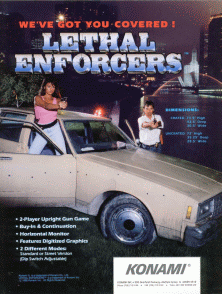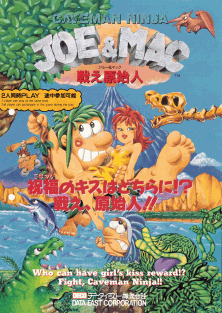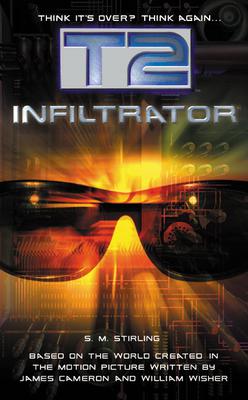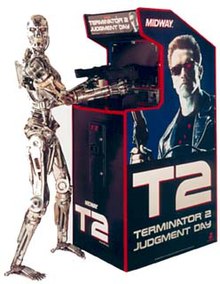
The T-1000 is a fictional character in the Terminator franchise. A shapeshifting android Terminator assassin, the T-1000 is the main antagonist of Terminator 2: Judgment Day, as well as an antagonist in Terminator Genisys and the theme park attraction T2 3-D: Battle Across Time. A similar Terminator, referred to as a T-1001, appears in the Fox television series, Terminator: The Sarah Connor Chronicles.
Terminator is an American media franchise created by James Cameron and Gale Anne Hurd. The franchise encompasses a series of science fiction action films, comics, novels and additional media, concerning a total war between Skynet's synthetic intelligence – a self-aware military machine network – and John Connor's Resistance forces comprising the survivors of the human race. Skynet's most famous products in its genocidal goals are the various terminator models, such as the T-800, who was portrayed by Arnold Schwarzenegger from the original Terminator film in 1984. By 2010, the franchise had generated $3 billion in revenue. The film franchise is considered to be of the cyberpunk subgenre of science fiction.

Sarah Jeanette Connor is a fictional character and the main protagonist of the Terminator franchise. She is one of the protagonists of The Terminator (1984), Terminator 2: Judgment Day (1991), Terminator Genisys (2015), and Terminator: Dark Fate (2019), as well as the television series Terminator: The Sarah Connor Chronicles (2008–2009). The character develops from a timid damsel in distress victim in the first film to a wanted fugitive committing acts of terrorism, a hardened warrior and mother who sacrificed everything for her son's future, on the verge of losing touch with her own humanity, and a mentor preparing and protecting a protégée for her destiny.

The Terminator, also known as a Cyberdyne Systems Model 101 or the T-800, is the name of several film characters from the Terminator franchise portrayed by Arnold Schwarzenegger and numerous actor stand-ins digitally overlaid with Schwarzenegger's likeness. The Terminator himself is part of a series of machines created by Skynet for infiltration-based surveillance and assassination missions, and while an android for his appearance, he is usually described as a cyborg consisting of living tissue over a robotic endoskeleton.

Lethal Enforcers is a 1992 light gun shooter released as an arcade video game by Konami. The graphics consist entirely of digitized photographs and digitized sprites. Home versions were released for the Super NES, Genesis and Sega CD during the following year and include a revolver-shaped light gun known as The Justifier.

T2-3D: Battle Across Time was an attraction at Universal Studios Florida, Universal Studios Hollywood and Universal Studios Japan. The version of the show in Hollywood had its final performance on December 31, 2012; the show then closed January 1, 2013. The version in Florida had its final performance on October 8, 2017; the show then closed October 9. The version in Osaka closed on September 14, 2020 in response to the COVID-19 pandemic, making the show on September 13, 2020, the final performance.

John Connor is a fictional character in the Terminator franchise. Created by writer/director James Cameron, the character is first referred to in the 1984 film The Terminator and first appears in its 1991 sequel Terminator 2: Judgment Day (T2). In the character's first appearance, John is portrayed by Edward Furlong as a child, and briefly by Michael Edwards as an adult in a small role. Other actors have portrayed the character in subsequent films, including Nick Stahl, Christian Bale, and Jason Clarke. In addition, Thomas Dekker portrayed John Connor in the two-season television series Terminator: The Sarah Connor Chronicles.

Jungle Strike is a video game developed and published by Electronic Arts in 1993 for the Sega Genesis/Mega Drive. The game was later released on several other consoles such as the Super Nintendo Entertainment System (SNES), and an upgraded version was made for DOS computers. The Amiga conversion was the responsibility of Ocean Software while the SNES and PC DOS versions were that of Gremlin Interactive, and the portable console versions were of Black Pearl Software. It is the direct sequel to Desert Strike and is the second installment in the Strike series. The game is a helicopter-based shoot 'em up, mixing action and strategy. The plot concerns two villains intent on destroying Washington, D.C. The player must use the helicopter and occasionally other vehicles to thwart their plans.

Joe & Mac, also known as Caveman Ninja and Caveman Ninja: Joe & Mac, is a 1991 run and gun platform game released for arcades by Data East. It was later adapted for the Super NES, Mega Drive/Genesis, Nintendo Entertainment System, Game Boy, Amiga, Zeebo, Nintendo Switch, and PC.

Skynet is a fictional artificial neural network-based conscious group mind and artificial general superintelligence system that serves as the antagonistic force of the Terminator franchise.

The T2 trilogy is a series of novels written by S. M. Stirling, set after the events of Terminator 2: Judgment Day, and first published in May 2001, which makes them the first works to officially continue the franchise. The series consists of three novels: T2: Infiltrator (2001), T2: Rising Storm (2003), and T2: The Future War (2004).

Terminator 2: Judgment Day is a 1991 American science fiction action film directed by James Cameron, who co-wrote the script with William Wisher. Starring Arnold Schwarzenegger, Linda Hamilton, Robert Patrick, and Edward Furlong, it is the sequel to The Terminator (1984) and is the second installment in the Terminator franchise. In the film, the malevolent artificial intelligence Skynet sends a Terminator—a highly advanced killing machine—back in time to 1995 to kill the future leader of the human resistance John Connor, when he is a child. The resistance sends back a less advanced, reprogrammed Terminator to protect Connor and ensure the future of humanity.

Doctor Miles Bennett Dyson is a character in the sci-fi franchise Terminator. He is the original inventor of the microprocessor which would lead to the development of Skynet, an intelligent computer system intended to control the United States military, but which would later achieve sentience and launch a global war of extermination against humanity.

Terminator 2: Judgment Day is a 1991 action video game developed by Dementia and published by Ocean Software. It is based on the 1991 film of the same name, and was released in Europe for Amiga, Amstrad CPC, Atari ST, Commodore 64, DOS, and ZX Spectrum. It is a sequel to The Terminator, itself based on the 1984 film of the same name. The game features several gameplay styles such as driving, fighting, and puzzle-solving.

Terminator 2: Judgment Day is a 1991 action-adventure game developed by Bits Studios and published by LJN. It is based on the 1991 film of the same name, and was released for the Game Boy. It was praised for its graphics, gameplay, and music.

Terminator 2: Judgment Day is an action game released for several 8-bit consoles, including the Nintendo Entertainment System (NES), and Sega's Game Gear and Master System. It is based on the 1991 film of the same name. The NES version was developed by Software Creations and published by LJN in February 1992. The Sega versions were published in late 1993, by Flying Edge.

Terminator 2: Judgment Day is a 1993 action game developed by Bits Studios for two 16-bit game consoles: the Sega Genesis and the Super Nintendo Entertainment System (SNES). It was published by Acclaim Entertainment through subsidiary companies: Flying Edge for the Genesis, and LJN for the SNES. It is based on the 1991 film of the same name, and features side-scrolling and driving levels. It received generally negative reviews.















